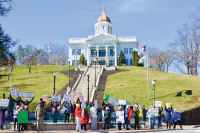Graveyards threatened by cremations and costs

Some of Western North Carolina’s greatest historical assets are in cemeteries.
They serve as the final resting place to founding families, Civil War soldiers, decorated military officers, Pulitzer Prize winners, and other historic figures that helped shape this region over two centuries. Maintaining these cemeteries — some of which date back to the early 1800s — is becoming a bigger burden for the few who still see the value in preserving a part of the past.
Whether it’s a church, a nonprofit organization or a local government that has taken on the role of caregiver, costs for upkeep are increasing and the number of people buying cemetery plots continues to decline.
According to a report from the National Funeral Directors Association, cremation rates surpassed burial rates in 2015 and projections show cremation services will make up 71 percent of funeral services by 2030. With more people choosing cremation over burial, caretakers have less money available from plot sales to put toward cemetery maintenance costs.
More people are choosing cremation over burial for a number of reasons — cremation is less expensive and it gives families the flexibly of being able to scatter the ashes, keep the remains or find other ways to honor their loved ones. It’s a trend professionals in the industry are seeing nationwide and it’s one they suspect will continue into the future.
Jennifer Greeley Jacobson of Wells Funeral Home with locations in Waynesville and Canton said about 40 percent of the families her business serves choose cremation services over a traditional cemetery burial.
Related Items
“With our cremation we’ve seen a 1 to 2 percent increase every year, and that’s been the trend for 10 for 15 years,” she said.
Ann Melton, a local historian and author of a book chronicling the history of Green Hill Cemetery in Waynesville, said she’s not surprised by the latest statistics. Her own research has shown much of the same. In fact, research shows that more than 80 percent of Americans were affiliated with a religion (mostly Christian denominations) in the 1970s, but today only 30 percent of people are affiliated with a certain religion. She said the lack of participation in the church has also contributed to deteriorating cemeteries.
“Times are changing. All these small churches are dying off because that’s not where young people want to go,” Melton said. “People in these small churches are getting older and it’s usually the people within the church that take care of the cemetery, so the cemeteries are growing up … it’s just sad.”
Funds drying up
Richard Jones has been a member of the Franklin Cemetery Association since 1972. The association was created in 1925 with the mission of maintaining Woodlawn Cemetery and many of the current association members are second-generation stakeholders with a vested interest in preserving the cemetery for future generations.
Jones took over the responsibility from his uncle when his health began to fail, but now he wonders who will step up to keep it going for another 40 years. The association relies on revenue from selling plots to help with the maintenance costs, but changes in the industry are making it more difficult to keep up.
“The big problem is the customs for burial now have changed dramatically,” Jones said. “More and more people are electing to have their remains burned instead of put in a grave in the ground — that and the income just is not hardly coming at all.”
The association currently has about $200,000 in perpetual care funds set up in a trust, but it can only access the interest accumulated each year to spend on maintenance costs.
“The total income from those funds is less than a third of what we need to generally maintain the cemetery,” Jones said.
Jones said plots are still available, though the cost has significantly increased over the last 30 years. The association sells individual plots for $625 each or a group of four plots together for $2,500, but he remembers when a four-grave lot only cost $800 to $1,000 in the 1970s.
The nonprofit association isn’t subject to income tax but does have to pay local taxes and must pay people to do the maintenance work. With limited funding, Jones said the association had to reduce how often the cemetery was mowed, but that led to a number of complaints from families visiting the grounds.
“Maintenance has not been as regular as we would have liked it, but it’s still in good shape,” Jones said.
The cemetery association is looking at several options — either find new members to serve on the association board or dissolve the association and hand the cemetery over to another nonprofit group, church or government entity. The association has approached the Macon County Board of Commissioners and the town of Franklin to see if either governmental body would be willing to take over the cemetery.
“As it presently stands, the board of trustees is very concerned about the well being and the continued maintenance of the cemetery and we have made a few advances to other individuals about taking over the project,” Jones wrote in a letter to commissioners. “We want to ensure, if at all possible, that it will continue to be operated for the benefit of the public in general and, in particularly, the families of those individuals who have been buried there since the cemetery was founded in 1922.”
Even though the cemetery is in good condition at the moment, Jones said county commissioners and the Franklin Board of Aldermen were not interested in taking over ownership of Woodlawn Cemetery.
“We were hopeful the town or the county would take it over, but neither of them felt this was a good move for them,” he said.
Now the association is in discussions with privately owned funeral homes to see if one of them can take over ownership of the cemetery. If any nonprofit, church or business is interested in helping, write to the Franklin Cemetery Association, 61 E. Main St., Franklin, NC, 28734.
Owning a cemetery
Managing a cemetery is something Jonathan Yates never expected to be doing with his life, but when the town of Waynesville restructured its departments a few years ago, the horticulturist found himself in charge of the town’s outdoor division, which includes the town’s parks and Green Hill Cemetery.
The founding date of Green Hill Cemetery is unknown, but Melton said the first mention of it was in an 1826 deed whereby Thomas Love conveyed 8 acres of a graveyard to the Trustees of Green Hill Academy. Her best assumption is the cemetery was a family graveyard for the Love family before it was given to the trustees.
The town now owns and maintains Green Hill. Yates said it costs the town about $190,230 a year from the general fund to maintain about 25.5 acres of the cemetery — that includes everything from mowing, employee salaries and benefits, supplies, utilities, and contracted labor.
“It’s a big responsibility. And it’s not just maintenance — we also still sell gravesites,” Yates said.
Plots at Green Hill run much higher than those at Woodlawn Cemetery in Franklin. A traditional burial plot is $1,500 each but the town also offers space in the urn garden for $1,000 for cremations only. There are also columbarium niche units for cremations only.
When the town collects $1,500 for a plot, $1,000 of it goes into a perpetual care fund and $500 goes into the town’s general fund. For the in-ground space in the urn garden, the town puts $600 toward the perpetual care fund, $200 in the general fund and $200 goes to pay for a flat granite stone marker.
“We have several options for people but a lot more folks seem to be going with cremation than in the past,” Yates said. “I think a lot of it comes down to money because of the high cost of burial.”
The town of Canton has owned and maintained Locust Field Cemetery for at least 50 years. The cemetery — located across from the Canton Public Library — was established in 1803 when Locust Field Baptist Church was first built and encompasses about 4.5 acres. Just like Green Hill, Locust Field is a point of interest on the North Carolina Civil War Trail.
The cemetery and church served as a campground and rallying point throughout the Civil War for Confederate soldiers. After the confederacy lost control at the battle of Cumberland Gap in September 1863, hundreds of soldiers that were part of 62nd NC Infantry escaped and set up refuge at Locust Fields. During the winter of 1864-65, the cemetery became a Confederate encampment again for Col. James Robert Love II — grandson of Waynesville’s founder Col. James Robert Love — and six companies of Thomas’ Legion. These soldiers took part in some of the last fights of the war in spring of 1865. Dozens of Confederate soldiers are buried in Locust Field.
Maintenance expenses — mostly mowing and weed eating — cost the town about $10,000 a year out of the general fund.
While the cemetery is no longer active, meaning plots are no longer being sold, Canton Town Manager Seth Hendler-Voss said there is still a value to keeping it maintained with taxpayer dollars.
“For many municipalities, cemeteries act as parks for exercising and cultural sites for education,” he said. “Cemeteries also serve as arboretums or tree preserves of sorts.”
While Canton and Waynesville have been in the cemetery business for a while, the town of Dillsboro only recently discovered that it owns the original one-acre tract that was the beginning of the historic Parris Cemetery.
As the town planning board was recently reviewing and updating all the town’s ordinances, members came upon an ordinance passed in the early 1980s that established a cemetery board of trustees for Parris Cemetery. They also discovered a deed at the courthouse dating back to 1940 in which the town was given the land. While the town owns the original cemetery land, the new section of the cemetery is privately owned by Ronnie Riddle.
Over time, the board of trustees for the cemetery has become inactive, with all the original members having passed away. Walter Wilson, the son of an original board member, has been acting with several individuals to maintain the cemetery.
“It’s flown under the radar for many years — the town didn’t know about it until a few months ago,” said Town Clerk Debbie Coffey. “The town has requested a survey be done by Burns Land Surveying to find out what portion we own.”
The town is also working to re-establish a board of trustees to oversee the cemetery and come up with a plan for future maintenance. The town’s ordinance also requires an annual financial statement be provided to the board of aldermen. This has not been provided to the town for some time. At this time the town does not budget general funds for support of the cemetery, but does distribute allocations from The N.C. Community Foundation Parris Cemetery Fund to Jackson Savings Bank.
Heritage tourism
There’s something mysterious yet beautiful about cemeteries that attract droves of people whether they’re photographing the unique headstones or searching for long-lost ancestors.
Anna Smathers Jorstad, communications manager for the Haywood County Tourism Development Authority, said the TDA receives plenty of calls and inquiries throughout the year about cemeteries from history buffs, Civil War enthusiasts and people trying to trace their ancestry.
“One of the many draws to Haywood County is its deep-rooted history and several of the cemeteries offer significant historical references to our heritage,” Jorstad said. “We saw this as an opportunity to share our unique history through these special places.”
The TDA began mentioning Haywood’s historic cemeteries — Green Hill, Bethel and Locust Field — in promotional material and on its website a few years ago during the Halloween season to highlight the heritage tourism niche available. Jorstad said the TDA encourages tourists visiting the cemeteries to do so with respect.
“We do not promote the cemeteries as some type of terrifying Halloween attraction because they are not — they are historical points of significance and the final resting place for many, so they are to be treated as such,” she said.
And if a cemetery can be considered a tourism-related attraction then it can potentially be eligible to receive grant funding from the TDA’s room tax revenue. The TDA recently granted funding to the town of Clyde for a special project at Pleasant Hill Cemetery. Within the past year, Jorstad said a separate cemetery was discovered marking the final resting place for a group of slaves that lived in Haywood County.
“For years, no one knew it was there, so it was an incredible discovery,” she said. “It was important to both the town of Clyde and the Haywood County TDA that this sacred place be well attended to and provided the appropriate markings and dedication that those buried there deserved.”
The town applied for TDA partnership funding and the committee granted them $4,067 to be used for the preservation and dedication of the cemetery — $2,567 of those funds will be used for tourism-related expenditures and $1,500 for promotional. The town is currently working on the plans for this project.
While cemeteries in Western North Carolina may not be home to any major celebrities, Green Hill is home to many historical figures, including Waynesville’s founder Col. James Robert Lowe. Not far from Lowe’s grave lies William Holland Thomas, the first and only white chief of the Cherokee Indians and founder of Thomas’ Legion — the only North Carolina Legion during the Civil War. Other notable gravesites include Pulitzer Prize winner Carolyn Miller and William Greer, a driver for five presidents and who was driving the car when John F. Kennedy was shot.
The town of Waynesville has recently been holding Living History Walks at the cemetery to raise awareness about the importance of preserving the site. The walking tour features town leaders dressed as the late historic figures and re-enactments of the famous or storied people buried there.
Melton said the walking tours were well attended and she hopes to do more in 2017. The Living History Walks and other heritage tourism-related efforts could be one viable way to increase awareness of historic cemeteries and create an additional revenue stream to help preserve them.
Melton has also been leading the charge to get Green Hill on the National Register of Historic Places, but it’s been a tedious process.
“It’s really hard to get a cemetery on the national registry,” she said. “There’s two ways to do it — either you have someone very famous buried there or you have tombstones or what they call funeral art.”
Green Hill does happen to have some recognized funeral art. Melton says the cemetery contains eight ornamental tombstones that were sculpted by W.O. Wolfe — father of Asheville author Thomas Wolfe. Since a cemetery in Hendersonville was placed on the national registry for having one W.O. Wolfe headstone, Melton feels hopeful Green Hill can make it too.
Even though Green Hill is already well maintained by the town, Melton hopes a national registry designation would help more people understand what a valuable asset the cemetery is to the community.
“The majority of people in Waynesville don’t know what’s up there and what an amazing place it is,” she said. “It would just be such an honor and maybe the people of Haywood County will realize what a treasure it is.”
By the numbers
Historic percentages of cremation and burial rates and future projections
2005 2010 2015 2017 2020 2030
Cremation 32.3 40.4 48.5 51.6 56 71.1
Burial 61.4 53.3 45.4 42.3 38 23.2
SOURCE: National Funeral Directors Association









